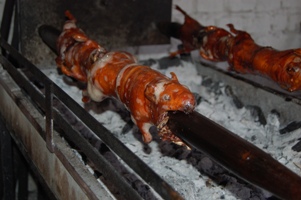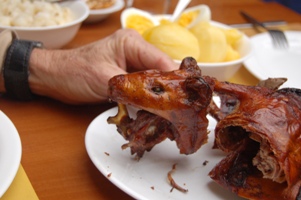By Heather Rath
ITWPA Member
“Try it!” he urges.
My husband invites a squirming me to sample roasted guinea pig (el cuy — pronounced koo-ie) in a specialized restaurant in Cuenca, Ecuador. A local insists we cannot leave Cuenca until we enjoy their favorite meal passed down from the Inca. For those who consider the guinea pig a pet, a visit to the Guajibamba restaurant is not advised.
The
Guinea pig meat is apparently healthy: high in protein, low in cholesterol and easy to digest. Still, looking on your plate at the spit-roasted creature with bared fangs and paws sticking straight up in the air is a bit disconcerting.
It is necessary to book a reservation in advance since a fresh guinea pig takes at least one hour to roast. The dish is served with boiled potatoes, hardboiled eggs, corn and a hot sauce.
“Be sure to eat the crunchy skin!” our companion tells us. “Especially the crispy ears.”
After a few bites, my husband finds his roasted guinea pig, including the liver, palatable — even delicioso. And before he gets a chance, I reach over, break off and finish those crispy, crackling ears.
If you’d like to purchase this article for your publication, click here to contact the author directly.


